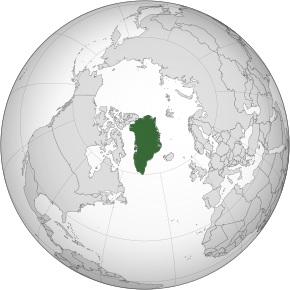
Greenland
Autonomous territory of the Kingdom of Denmark in North America / From Wikipedia, the free encyclopedia
Dear Wikiwand AI, let's keep it short by simply answering these key questions:
Can you list the top facts and stats about Greenland?
Summarize this article for a 10 year old
Greenland (Greenlandic: Kalaallit Nunaat, pronounced [kalaːɬːit nʉnaːt]; Danish: Grønland, pronounced [ˈkʁɶnˌlænˀ]) is a North American island autonomous territory[14] of the Kingdom of Denmark.[15] It is the larger of two autonomous territories within the Kingdom, the other being the Faroe Islands; the citizens of both territories are full citizens of Denmark. As Greenland is one of the Overseas Countries and Territories of the European Union, citizens of Greenland are European Union citizens.[16] The capital and largest city of Greenland is Nuuk.[16] Greenland lies between the Arctic and Atlantic oceans, east of the Canadian Arctic Archipelago. It is the world's largest island,[lower-alpha 4] and is the location of the northernmost point of land in the world – Kaffeklubben Island off the northern coast is the world's northernmost undisputed point of land, and Cape Morris Jesup on the mainland was thought to be so until the 1960s.
This article needs additional citations for verification. (October 2023) |
Greenland | |
|---|---|
| Anthem: "Nunarput, utoqqarsuanngoravit" (Greenlandic) "You Our Ancient Land" | |
| Kalaallit song: "Nuna asiilasooq" (Greenlandic) "The Land of Great Length"[lower-alpha 1] | |
 Location of Greenland | |
| Sovereign state | Denmark |
| Union with Norway | 1262 |
| Danish-Norwegian recolonization | 1721 |
| Cession to Denmark | 14 January 1814 |
| Home rule | 1 May 1979 |
| Further autonomy and self rule | 21 June 2009[2][3] |
| Capital and largest city | Nuuk 64°10′N 51°44′W |
| Official languages | Greenlandic[lower-alpha 2] |
| Recognized languages | Danish, English, and other languages if necessary[lower-alpha 2] |
| Ethnic groups (2020[5]) | |
| Religion | Christianity (Church of Greenland) |
| Demonym(s) |
|
| Government | Devolved government within a parliamentary constitutional monarchy |
• Monarch | Frederik X |
| Mette Frederiksen | |
| Julie Præst Wilche | |
| Múte Bourup Egede | |
| Mimi Karlsen | |
| Legislature | Folketinget (Realm legislature) Inatsisartut (Local legislature) |
| National representation | |
| 2 members | |
| Area | |
• Total | 2,166,086 km2 (836,330 sq mi) |
• Water (%) | 83.1[lower-alpha 3] |
| Highest elevation | 3,700 m (12,100 ft) |
| Population | |
• 2022 estimate | |
• Density | 0.028/km2 (0.1/sq mi) |
| GDP (PPP) | 2011 estimate |
• Total | $1.8 billion[8] |
• Per capita | $37,000 |
| GDP (nominal) | 2020 estimate |
• Total | DKK 20.1 billion[9] $3.08 billion[10] |
• Per capita | DKK 358,000[9] $54,694[11] |
| Gini (2015) | medium |
| HDI (2010) | high · 61st |
| Currency | Danish krone (DKK) |
| Time zone | UTC±00:00 to UTC-04:00 |
| Date format | dd-mm-yyyy |
| Driving side | right |
| Calling code | +299 |
| Postal codes | 39xx |
| ISO 3166 code | GL |
| Internet TLD | .gl |
Though a part of the continent of North America, Greenland has been politically and culturally associated with Europe (specifically Norway and Denmark, the colonial powers) for more than a millennium, beginning in 986.[18] Greenland has been inhabited at intervals over at least the last 4,500 years by circumpolar peoples whose forebears migrated there from what is now Canada.[19][20] Norsemen settled the uninhabited southern part of Greenland beginning in the 10th century (having previously settled Iceland), and the 13th century saw the arrival of Inuit. Though under continuous influence of Norway and Norwegians, Greenland was not formally under the Norwegian crown until 1261. The Norse colonies disappeared in the late 15th century, after Norway was hit by the Black Death and entered a severe decline.
In the early 17th century, Dano-Norwegian explorers reached Greenland again. When Denmark and Norway separated in 1814, Greenland was transferred to the Danish crown, and was fully integrated in the Danish state in 1953 under the Constitution of Denmark, which made the people in Greenland citizens of Denmark. In the 1979 Greenlandic home rule referendum, Denmark granted home rule to Greenland; in the 2008 Greenlandic self-government referendum, Greenlanders voted for the Self-Government Act, which transferred more power from the Danish government to the local Naalakkersuisut (Greenlandic government).[21] Under this structure, Greenland gradually assumed responsibility for a number of governmental services and areas of competence. The Danish government retains control of citizenship, monetary policy, and foreign affairs, including defence. Most residents of Greenland are Inuit.[22]
The population is concentrated mainly on the southwest coast, and the rest of the island is sparsely populated. Three-quarters of Greenland is covered by the only permanent ice sheet outside Antarctica. With a population of 56,583 (2022),[23] Greenland is the least densely populated region in the world.[24] Sixty-seven percent of its electricity production comes from renewable energy, mostly from hydropower.[25]

